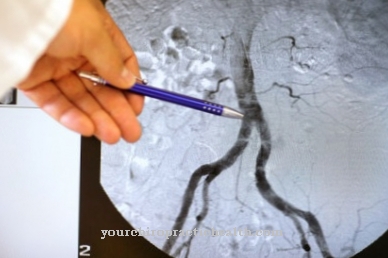anthrax or. Anthrax is an infectious disease caused by bacteria. It is usually very rare in humans. It is more likely to be found in ungulates, which, however, can transmit the anthrax pathogens if they come into close contact with humans. Skin anthrax is most common in humans. Unfortunately, there are also biological warfare agents based on the anthrax pathogen.
What is anthrax?

© macrovector - stock.adobe.com
At anthrax, also Anthrax called, it is an infectious disease caused by bacteria. This occurs mainly in herbivorous animals and can also infect humans through intensive contact with them. The term anthrax goes back to the enlarged and "burned" looking spleen.
Anthrax is found mainly in warmer countries. Increased numbers of ungulates such as horses, goats, cattle, pigs and sheep are affected. This is also the reason why people who come into contact with these animals or their products are particularly at risk. In Germany, however, there have been very few cases of anthrax in recent years.
causes
As the cause of anthrax is considered infection with a bacterium called Bacillus anthracis. This bacterium forms spores and in this way reduces its vital functions to a minimum, which in turn gives it the opportunity to survive for years. In addition, the pathogen has a special protein capsule, which enables it to evade animal and human defense mechanisms. On top of that, the bacterium itself forms toxins when it is destroyed, which are then passed on to the organism.
These toxins damage blood vessels and make them passable for red blood cells. The result is that the human or animal organism causes inflammation and bleeding. As a result, there is swelling of the affected tissue, which is preferably skin, lungs or intestines.
The transmission of anthrax can happen in different ways. Most minor skin injuries are infected directly with anthrax spores, leading to skin anthrax. In contrast, pulmonary anthrax, in which humans become infected through the respiratory tract and the associated inhalation of spores, is less common. Anthrax of the intestines is also rather rare and is transmitted through raw meat or untreated fresh milk.
Symptoms, ailments & signs
Depending on how the anthrax pathogens got into the body, different symptoms and complaints can occur. If the pathogens entered through a skin tear or an inflamed area, swellings and blisters develop in the affected area.As the growth progresses, an ulcer develops, which in turn forms black scabs.
As a result of injuries to the veins, hematomas develop in the surrounding region. If the bacteria have been inhaled, the first symptoms appear after three to ten days. Then it comes to typical flu symptoms such as fever, chills, fatigue and malaise. In the further course there may be difficulty breathing and a dry cough.
If the symptoms occur after consuming contaminated food, a period of three to seven days can be expected. During this period, in addition to general symptoms such as nausea and vomiting, gastrointestinal complaints such as diarrhea, loss of appetite or heartburn occur. In addition, there may be bleeding in the intestinal tract, which is noticeable in bloody diarrhea and vomiting of blood.
Edema can form in the abdominal area. In addition, ulcers and infections occur, which can be localized in different parts of the body. With appropriate treatment, the symptoms subside after a few days to weeks. In severe cases, the disease is fatal.
Course of disease
The course of the Anthrax depends entirely on the shape of the anthrax. For example, if treatment is delayed or not treated at all, intestinal and pulmonary anthrax can end with death after a maximum of three days. In addition, there is a high probability that the anthrax will cause blood poisoning, regardless of the type. This can manifest itself, among other things, with fever, skin bleeding, enlarged spleen or circulatory shock. In around 20 percent, this leads to death without treatment. With timely antibiotic therapy, however, the death rate from anthrax is extremely minimized.
Complications
Depending on its shape, anthrax can cause a number of serious complications of the lungs, skin, and intestines. In the case of pulmonary anthrax, bronchitis-like symptoms such as coughing up blood, vomiting and chills first appear. This can lead to severe respiratory impairment, which often results in acute shortness of breath and suffocation.
In the course of skin anthrax, skin damage such as eczema and edema occur, which can become inflamed. The lymph vessels and lymph nodes can become inflamed and swollen in the course of the disease, associated with an increased susceptibility to infection and an intense feeling of illness. Intestinal anthrax can develop into peritonitis, causing a ruptured bowel, sepsis, and other complications.
This is accompanied by intestinal bleeding and diarrhea, causing infections and dehydration. Rarely, an anthrax infection can develop into severe meningitis. In anthrax therapy, the prescribed anti-body medication can cause serious side effects.
The frequently used preparation Ciprobay can trigger allergic reactions, seizures, anxiety and depression, among other things. Surgical interventions are associated with a high risk of sepsis. It can also lead to bleeding, excessive scarring and severe sensory disturbances.
When should you go to the doctor?
Since anthrax is a serious infectious disease, a doctor should always be consulted. Early diagnosis and treatment have a very positive effect on the course of the disease. The doctor should be consulted if the person concerned has been bitten by an animal and the bite wound has become infected. An ulcer there can also indicate anthrax and should always be examined by a doctor. Furthermore, the illness makes itself felt as fatigue, fever or chills.
Those affected appear sick, tired and can no longer actively participate in everyday life. In many cases, there is a strong cough or other breathing difficulties. Not infrequently, loss of appetite or heartburn also indicate anthrax. The condition can be diagnosed and treated by a general practitioner or in a hospital. As a rule, the disease progresses positively and without complications. An early diagnosis always has a positive effect on the further course of the disease.
Treatment & Therapy
At anthrax early drug treatment with antibiotics must take place. Even in the event of suspicion, this should be done as a preventive measure and should last for 60 days. In the case of cutaneous anthrax, treatment with penicillin should be used. For intestinal and pulmonary anthrax, however, doxycycline or ciprofloxacin must be used. In addition, the specific complaints must be treated with painkillers and the affected parts of the body must be immobilized.
However, any surgical intervention in the case of cutaneous anthrax is prohibited, as the risk of blood poisoning would be far too high in this case. On top of that, those affected should be isolated. However, people must also be treated who have come into contact with anthrax but have not yet been ill. In this case, antibiotics are used coupled with a vaccine against anthrax.
Outlook & forecast
The prognosis for anthrax in humans is generally poor. The exact prognosis depends on the location of the anthrax infection and the accessibility to antibiotics. Intestinal anthrax and pulmonary anthrax are roughly fatal in most cases if left untreated. In the case of intestinal anthrax, around 50 percent of people treated with medication also die.
Of all forms of anthrax, skin anthrax has the best chances of a cure: a dose of antibiotics is usually sufficient if the disease has not yet spread to the whole body. The affected areas of skin can heal again with good wound cleaning and adequate protection. Scarring usually occurs. Even if left untreated, a maximum of one fifth of cases are fatal.
With pulmonary anthrax, most patients die about three to six days after the full symptoms appear. Some of the surviving patients have severe damage to their lungs and their breathing can be permanently impaired. Colon anthrax is also often fatal. The pathogen can spread to other organs very quickly and trigger various infections, which is the reason for the high mortality.
Although anthrax can be treated, the toxins released are so dangerous in advanced disease that even drugs often cannot prevent death. Fast therapy is therefore important for a good prospect of treatment success.
Aftercare
Infectious diseases often need good follow-up care after they have healed. It is aimed at strengthening the immune system, regenerating those affected and, above all, aiming to prevent the disease from flaring up again. In the case of anthrax, follow-up care focuses primarily on wound healing. It is important to ensure that the affected skin area remains free of dirt in order to avert further infection. This is achieved by carefully covering the area, but also by leaving a scab on the skin until it falls off on its own. It is also important not to start sporting activities too early if the person concerned is not yet able to perform well enough.
Due to the strong side effects that can occur when taking the medication, those affected are sometimes taken with anxiety and depressive moods, allergic reactions and seizures are also possible. After the procedure, scarring, bleeding and severe sensory disturbances can occur, which is why it is necessary to closely monitor the healing process. A gentle mode with enough sleep and the help of friends and acquaintances increase well-being and stimulate recovery.
You can do that yourself
Patients suffering from anthrax must first and foremost take it easy. In the first few days, strict bed rest and stress avoidance apply. In terms of nutrition, we recommend that you drink plenty of fluids and eat foods that strengthen the immune system. In addition to classics such as rusks and meat broth, fruit and vegetables as well as hot chamomile or ginger tea also help.
In addition, the respective symptoms must be counteracted in a targeted manner. Cold compresses help with a fever, while coughing and shortness of breath can be relieved by inhaling a saline solution. If you have chills, it is best to take a hot bath. A proven natural remedy is the bark of the red cinchona tree, which is brewed and drunk in small sips.
If the symptoms are severe, the doctor should prescribe a mild antipyretic drug. Nausea and vomiting usually go away after one or two days, during which time you should follow a gentle diet and soothe the stomach with warm pads. If the symptoms do not subside after a few days, you must definitely see a doctor again if you have anthrax. In the event of complications such as blood poisoning or meningitis, the nearest hospital should be visited immediately.


.jpg)





.jpg)



















